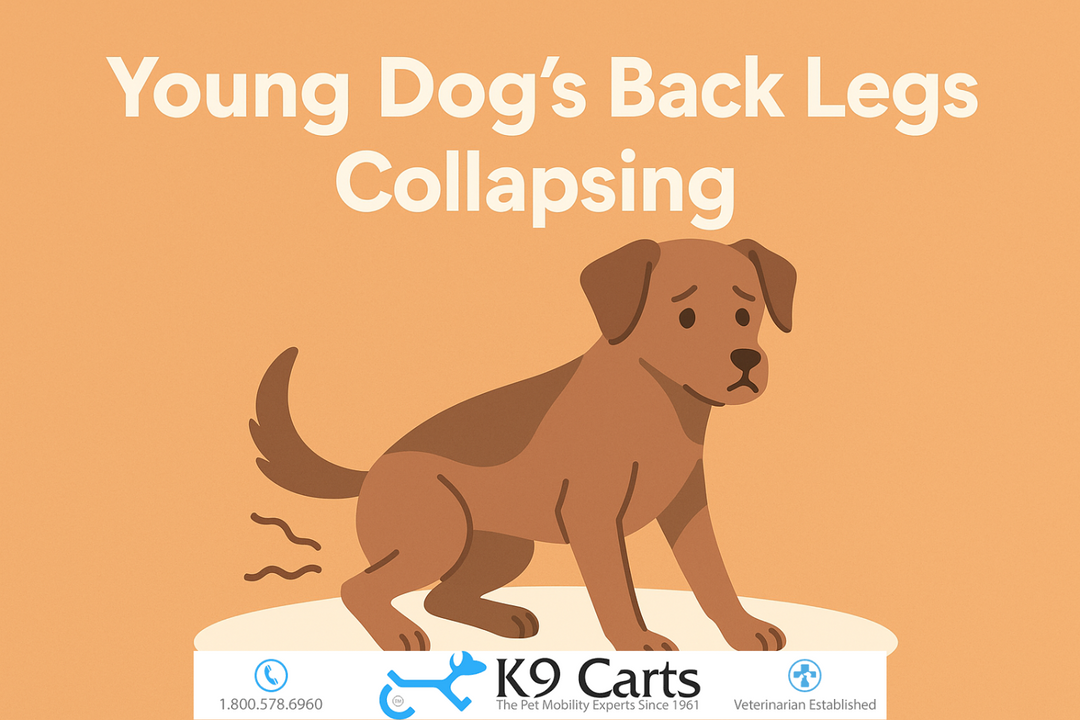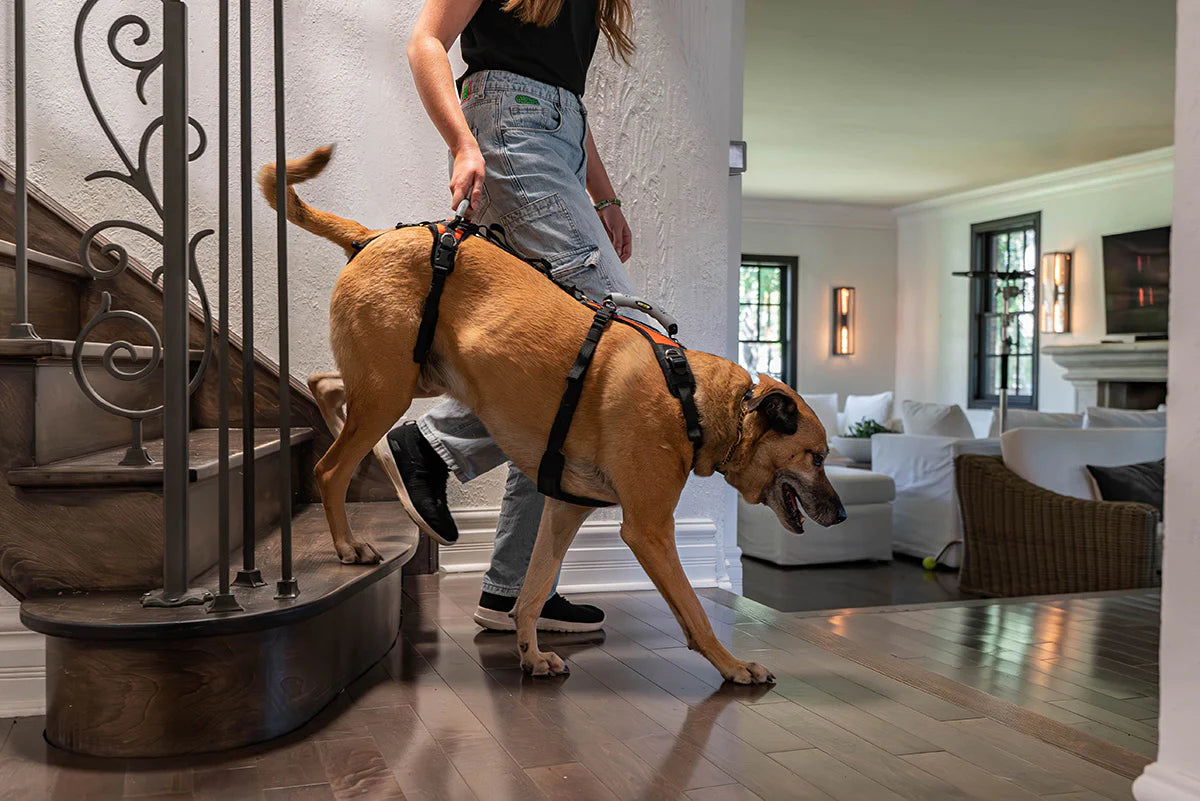Young Dog’s Back Legs Collapsing: Causes and What to Do

When a young dog suddenly starts to collapse in the back legs, it can be alarming and confusing for any pet owner. This isn’t just a sign of tiredness or a minor injury. It can point to underlying health issues that require attention. While back leg weakness is often associated with aging dogs, there are many cases where it affects puppies and young adult dogs.
Understanding the causes of back leg collapse and knowing how to respond can make a major difference in your dog’s comfort, recovery, and long-term mobility. In this article, we’ll break down the most common causes, what symptoms to watch for, how veterinarians diagnose the condition, and what treatment options are available.
What does it mean when a young dog's back legs collapse?
When a young dog’s back legs collapse, it means the hind limbs lose strength, coordination, or function. This might look like stumbling, dragging the rear legs, wobbling, or completely falling down. These episodes can happen suddenly or come on gradually. The collapse can last seconds or be ongoing.
This symptom is a sign of an underlying problem. It doesn’t point to a single condition, but instead to a variety of possible neurological, muscular, skeletal, or metabolic issues.
What are the common causes of hind leg collapse in young dogs?
1. Congenital neurological disorders
Some dogs are born with conditions that affect the brain, spinal cord, or peripheral nerves. These issues can disrupt signals to the hind legs.
-
Spinal cord malformations: Conditions like hemivertebrae or spina bifida can interfere with normal nerve transmission.
-
Inherited neuropathies: Breeds like Labrador Retrievers, German Shepherds, and Boxers can inherit early-onset degenerative conditions that affect nerve function.
2. Intervertebral disc disease (IVDD)
Although more common in middle-aged dogs, IVDD can affect young dogs, especially certain breeds like Dachshunds and Corgis. The discs between the spinal vertebrae can bulge or rupture, putting pressure on the spinal cord and causing weakness or paralysis in the back legs.
3. Hip dysplasia
Hip dysplasia is often thought of as a condition of older dogs, but symptoms can appear in puppies as young as five months. It results from abnormal hip joint development and can cause pain, weakness, and difficulty standing or walking.
4. Trauma or injury
Falls, car accidents, or rough play can cause spinal fractures, disc damage, or ligament injuries. In young dogs with softer bones, even minor trauma can lead to serious consequences.
5. Inflammatory or infectious diseases
-
Meningitis or encephalitis can affect the spinal cord and brain.
-
Tick-borne diseases such as Lyme disease or ehrlichiosis can cause joint inflammation and muscle weakness.
-
Distemper virus can cause neurological symptoms in unvaccinated dogs.
6. Nutritional deficiencies
Puppies with poor diets or absorption issues may suffer from deficiencies in calcium, vitamin D, or B vitamins, leading to bone or nerve problems that affect mobility.
7. Juvenile onset arthritis
Some dogs develop arthritis very early due to autoimmune diseases or joint abnormalities. Swollen, painful joints in the hind legs can result in collapse or reluctance to bear weight.
8. Degenerative myelopathy (rare in young dogs)
Though extremely rare in dogs under five years old, early-onset forms of degenerative myelopathy have been reported in breeds with genetic mutations. This condition affects the spinal cord and progressively weakens the hind limbs.
What symptoms should you watch for besides back leg collapse?
Back leg collapse is often just one part of a bigger picture. Additional signs can help your veterinarian pinpoint the cause.
Look for:
-
Shaking or trembling in the rear legs
-
Loss of balance or coordination
-
Knuckling or dragging of the feet
-
Difficulty standing up or climbing stairs
-
Loss of bladder or bowel control
-
Signs of pain (yelping, whimpering, licking the back or hips)
-
Muscle atrophy in the hindquarters
-
Changes in gait or posture
Taking a video of your dog when symptoms occur can be very helpful for your veterinarian’s evaluation.
How is the cause of back leg collapse diagnosed in young dogs?
Your veterinarian will start with a physical exam and review of your dog’s history. They may ask when symptoms started, whether they’ve worsened, and if any injuries occurred.
Common diagnostic tools include:
-
X-rays to look at bones and joints
-
MRI or CT scans for detailed views of the spinal cord and discs
-
Blood tests to check for infections, inflammation, or deficiencies
-
Neurological exam to test reflexes and coordination
-
Genetic testing if a breed-related condition is suspected
-
Joint taps or cerebrospinal fluid analysis to look for infection or autoimmune activity
What treatment options are available for young dogs with hind leg collapse?
Medical treatments
Treatment depends on the underlying cause.
-
Anti-inflammatory medications: Often prescribed for IVDD, arthritis, or joint inflammation.
-
Antibiotics or antivirals: For infections such as distemper or Lyme disease.
-
Surgery: In cases of spinal injury, disc herniation, or hip dysplasia, surgical correction may be required.
-
Physical therapy: Helps rebuild strength, improve coordination, and prevent muscle atrophy.
-
Supplements: Omega-3s, glucosamine, and vitamin B can support joint and nerve health.
At-home care
-
Limit activity until diagnosis is confirmed.
-
Use non-slip rugs or traction socks to help with footing.
-
Assist your dog with a sling or support harness if needed.
-
Use ramps instead of stairs.
-
Monitor for pain, bathroom accidents, or worsening symptoms.
When is a dog wheelchair appropriate for a young dog?
If a young dog experiences persistent weakness, partial paralysis, or full hind limb paralysis, a custom-built wheelchair can be a safe and effective solution. It allows the dog to remain mobile without straining the rest of the body.
Wheelchairs are particularly helpful in these scenarios:
-
Post-surgical recovery where mobility is limited
-
Chronic conditions like early-onset arthritis or IVDD
-
Neurological conditions that impair movement but don’t affect cognition or overall health
-
Long-term rehabilitation plans where strength will improve over time
K9 Carts offers lightweight, adjustable, and veterinarian-designed wheelchairs that are tailored to each dog’s exact measurements. The wheelchairs support the hips without putting pressure on the spine, allowing your dog to walk, play, and stay active while healing or managing a condition.
Many dogs adapt quickly to their carts and regain a high quality of life. For young dogs, early mobility support can even prevent long-term complications from muscle wasting or joint stiffness.
How to support your young dog’s mobility long term
Long-term mobility care involves more than treating the initial issue. Young dogs with hind leg collapse often need ongoing support to maintain comfort and strength.
Tips for long-term care:
-
Keep your dog at a healthy weight to avoid extra stress on joints
-
Regular checkups to monitor progress or detect any changes
-
Consistent physical therapy or swimming sessions
-
Provide joint-supportive bedding and orthotic accessories if needed
-
Continue using mobility aids like slings or carts when appropriate
Helping your dog stay mobile and happy
Seeing your young dog’s back legs collapse can be difficult, but it's important to know that with the right diagnosis and treatment, many dogs make excellent progress. Whether your dog is healing from an injury, dealing with a neurological condition, or managing a long-term disability, there are tools available to keep them moving.
Early intervention, veterinary care, and mobility support like a custom-fitted dog wheelchair can make a significant difference in your dog’s quality of life. Staying proactive and informed gives your dog the best chance at an active, pain-free future.
Frequently Asked Questions
What should I do first if my young dog’s back legs suddenly give out?
If your young dog’s back legs suddenly give out, the first step is to keep your dog calm and restrict movement to prevent further injury. Sudden hind leg collapse can be a sign of a serious underlying condition such as a spinal injury, neurological disorder, or orthopedic issue. Contact your veterinarian immediately to schedule an evaluation. Avoid giving any medications unless directed. A video of the collapse may help your vet with the diagnosis. Early veterinary attention is critical to prevent permanent damage.
Can a young dog recover from back leg paralysis?
Yes, many young dogs can recover from back leg paralysis, depending on the cause and how quickly treatment begins. Conditions like spinal trauma, intervertebral disc disease, or inflammation can often be treated with a combination of surgery, medication, and physical therapy. Some cases may require long-term mobility support, including a custom-fitted dog wheelchair. Early intervention improves outcomes significantly. Always follow your veterinarian’s rehabilitation plan to give your dog the best chance at regaining mobility.
How do I know if my dog needs a wheelchair or just rest and rehab?
A dog may need a wheelchair if there is consistent hind limb weakness, partial paralysis, or difficulty walking that does not improve with rest alone. Wheelchairs are especially helpful for dogs undergoing rehabilitation, as they allow mobility while preventing muscle loss. If your dog cannot support weight on the back legs, drags their hind limbs, or struggles with balance over time, a professionally fitted wheelchair can help maintain quality of life. Your veterinarian can confirm whether mobility support is appropriate.
What breeds are more prone to early hind leg weakness?
Breeds more prone to early hind leg weakness include Dachshunds, Corgis, French Bulldogs, and German Shepherds. These breeds are genetically predisposed to conditions like intervertebral disc disease, hip dysplasia, and degenerative myelopathy. Some large breed puppies can also experience orthopedic growth disorders. Knowing your breed’s risk factors allows for early monitoring and preventive care. Regular checkups and appropriate exercise can help detect and manage early symptoms.
Can puppies develop arthritis or hip dysplasia?
Yes, puppies can develop arthritis or hip dysplasia, especially in breeds genetically predisposed to joint issues. Hip dysplasia often begins during growth stages and can show symptoms as early as five to six months. Juvenile arthritis, though less common, is another condition that can cause joint inflammation and mobility issues in young dogs. If your puppy is limping, stiff, or reluctant to move, seek veterinary evaluation. Early diagnosis and treatment can slow disease progression and reduce discomfort.
How can I help my young dog with weak back legs at home?
To help your young dog with weak back legs at home, provide non-slip flooring, ramps in place of stairs, and supportive bedding to reduce joint strain. Use a sling or rear support harness to assist with walks. Keep your dog at a healthy weight to minimize pressure on the spine and hips. Gentle, low-impact exercises such as hydrotherapy can build muscle without adding stress. Always consult your vet before starting any home care routine to ensure it fits your dog’s diagnosis.
Is back leg collapse in young dogs always a permanent condition?
No, back leg collapse in young dogs is not always permanent. Many cases are temporary and can resolve with proper treatment. For example, inflammation, mild trauma, or early-stage IVDD can improve significantly with medication and rest. Other conditions, such as infections or nutritional deficiencies, are also treatable. However, permanent disability can result if the cause is not addressed early. Timely veterinary care, diagnostics, and ongoing support give your dog the best chance at full or partial recovery.
What signs show that back leg weakness is getting worse?
Worsening back leg weakness in dogs may show as increased stumbling, frequent falling, loss of coordination, dragging of feet, or reduced muscle tone in the hindquarters. In severe cases, your dog may lose bladder or bowel control. If your dog becomes unable to rise or walk at all, or the symptoms spread to the front legs, seek emergency veterinary attention. Tracking changes through video and written notes helps your vet adjust treatment and recommend supportive care options.
Can a dog live a happy life using a wheelchair?
Yes, many dogs live active and fulfilling lives using a wheelchair. A properly fitted dog wheelchair supports mobility, prevents secondary injuries, and allows dogs to play, walk, and socialize. Young dogs often adapt quickly and regain confidence once they’re able to move without pain or imbalance. Custom-built wheelchairs from experienced providers like K9 Carts are designed to fit your dog’s anatomy and condition, ensuring safety and comfort. With regular use and proper care, wheelchairs can significantly improve your dog’s independence.








